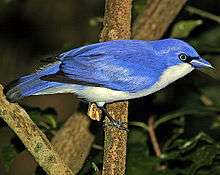Blue vanga
| Blue vanga | |
|---|---|
 | |
| Scientific classification | |
| Kingdom: | Animalia |
| Phylum: | Chordata |
| Class: | Aves |
| Order: | Passeriformes |
| Family: | Vangidae |
| Genus: | Cyanolanius Bonaparte, 1854 |
| Species: | C. madagascarinus |
| Binomial name | |
| Cyanolanius madagascarinus | |
| Synonyms | |
|
Loxia madagascarina Linnaeus, 1766 | |
The blue vanga (Cyanolanius madagascarinus) is a bird species in the family Vangidae. It is in the monotypic genus Cyanolanius.[2] It is found in Comoros, Madagascar, and Mayotte, where its natural habitats are subtropical or tropical dry forest and subtropical or tropical moist lowland forest.[1]
A taxon found on the Comoros Islands, the Comoro blue vanga is considered by most authorities to be a subspecies of the blue vanga (C. m. comorensis), though it has occasionally been considered a separate species, Cyanolanius comorensis.
In 1760 the French zoologist Mathurin Jacques Brisson included a description of the blue vanga in his Ornithologie based on a specimen collected on the island of Madagascar. He used the French name Le pie-griesche bleu de Madagascar and the Latin Lanius Madagascariensis coeruleus.[3] Although Brisson coined Latin names, these do not conform to the binomial system and are not recognised by the International Commission on Zoological Nomenclature.[4] When in 1766 the Swedish naturalist Carl Linnaeus updated his Systema Naturae for the twelfth edition, he added 240 species that had been previously described by Brisson.[4] One of these was the blue vanga. Linnaeus included a brief description, coined the binomial name Loxia madagascarina and cited Brisson's work.[5] The species is now placed in the genus Cyanolanius that was introduced by the French naturalist Charles Lucien Bonaparte in 1854.[6]
Three subspecies are recognised:[7]
- C. m. madagascarinus (Linnaeus, 1766) – Madagascar
- C. m. comorensis (Shelley, 1894) – Mohéli in the Comoro Islands
- C. m. bensoni Louette & Herremans, 1982 – Grande Comore in the Comoro Islands
References
- 1 2 BirdLife International. 2016. Cyanolanius madagascarinus. The IUCN Red List of Threatened Species 2016: e.T103703584A94147463. https://dx.doi.org/10.2305/IUCN.UK.2016-3.RLTS.T103703584A94147463.en. Downloaded on 31 July 2018.
- ↑ "ITIS Report: Cyanolanius". Integrated Taxonomic Information System. Retrieved 8 August 2014.
- ↑ Brisson, Mathurin Jacques (1760). Ornithologie, ou, Méthode contenant la division des oiseaux en ordres, sections, genres, especes & leurs variétés (in French and Latin). Volume 2. Paris: Jean-Baptiste Bauche. pp. 197–200, Plate 16 fig 3. The two stars (**) at the start of the section indicates that Brisson based his description on the examination of a specimen.
- 1 2 Allen, J.A. (1910). "Collation of Brisson's genera of birds with those of Linnaeus". Bulletin of the American Museum of Natural History. 28: 317–335.
- ↑ Linnaeus, Carl (1766). Systema naturae : per regna tria natura, secundum classes, ordines, genera, species, cum characteribus, differentiis, synonymis, locis (in Latin). Volume 1, Part 1 (12th ed.). Holmiae (Stockholm): Laurentii Salvii. p. 306.
- ↑ Bonaparte, Charles Lucien (1854). "Notes sur les collections rapportées en 1853, par M. A. Delattre, de son voyage en Californie et dans le Nicaragua". Comptes Rendus Hebdomadaires des Séances de l'Académie des Sciences. 38: 387, 538.
- ↑ Gill, Frank; Donsker, David, eds. (2018). "Batises, woodshrikes, bushshrikes, vangas". World Bird List Version 8.1. International Ornithologists' Union. Retrieved 21 June 2018.
